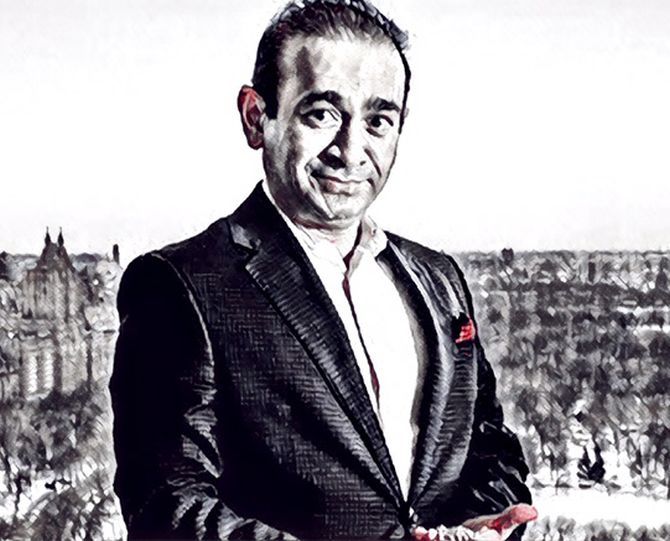From flashy diamantaire to fugitive: Nirav Modi’s long road to extradition
The diamond merchant wanted in India on charges of fraud and money laundering in the estimated $2-billion Punjab National Bank scam case, lost his legal battle against extradition as a UK judge ruled that he does have a case to answer before the Indian courts.
Nirav Modi’s story up until the United Kingdom court verdict on Thursday, just two days before his 50th birthday, is one of stark contrasts.
From someone flush with diamonds, quite literally, as a member of a Gujarati family of gem traders who grew up in the European jewellery hub of Antwerp in Belgium, to ending up holed up in a jail cell in one Europe’s most overcrowded prisons.
The diamond merchant wanted in India on charges of fraud and money laundering in the estimated $2-billion Punjab National Bank scam case, lost his legal battle against extradition as a UK judge ruled that he does have a case to answer before the Indian courts.
He has been lodged at Wandsworth Prison in south-west London since his arrest on an extradition warrant in March 2019 at a central London bank branch, where he was trying to set up a new account.
He had been staying nearby at a plush penthouse in Centrepoint in the heart of the UK capital, regularly walking his dog to an apparently new jewellery business nearby.
It later emerged during remand hearings at Westminster Magistrates’ Court in London that he had hired Boutique Law LLP in anticipation of the extradition proceedings on charges of fraud and money laundering by the Central Bureau of Investigation and Enforcement Directorate, trying to strike a voluntary surrender and bail deal.
However, as the CBI and ED evidence was presented in court by the Crown Prosecution Service, arguing on behalf of the Indian authorities, his offer of up to GBP 4 million as security to be allowed to be bailed under strict house arrest conditions was repeatedly rejected.
His detention in a shared cell with one other inmate is a far cry from his past billionaire lifestyle, which involved hobnobbing with high-profile celebrities and his diamond designs finding red carpet favour with stars.
“I was totally impressed with the craftsmanship at the workshop [in India]. It was the best quality I could see anywhere in the world,” Thierry Fritsch, a high-end French jewellery expert, told the UK court during the course of the extradition hearing last year.
As someone who had served on the Advisory Board of Nirav Modi’s company for three years since 2015, Fritsch was deposed by the defence team to vouch for Nirav’s “integrity” and skills as an entrepreneur and creative person, who was passionate about establishing the first international brand of luxury jewellery out of India.
A gems expert, Dr Richard Taylor, was also fielded to go into the nitty-gritties of the diamond trade and how the Nirav Modi brand had succeeded in making a mark around the world.
“The industry relies on sending out high-value product to companies and to do that they require trust and confidence,” said Taylor, in an attempt to establish Modi’s credibility in the business.
“India is the largest and most important centre of diamond cutting, it was a very significant trend that he [Modi] was part of,” he added.
The picture painted in court was one of a talented jewellery designer who was only driven by one mission — to make the Nirav Modi brand worthy of competition with the likes of global luxury jewellery brands such as Tiffany or Cartier. And, the accusations associated with the extradition case were painted as nothing more than a commercial dispute.
The CPS, in turn, presented documents and video evidence in an effort to establish a complex web of misuse of a bank credit facility called letters of undertaking and threats issued to so-called ‘dummy directors’ of front companies to keep them out of the reach of Indian investigative authorities.
Throughout the extradition case in London, Nirav Modi’s depression and mental health condition remained at the heart of arguments with his extended incarceration said to have worsened his condition.
“Coupled with a severe condition of depression, in my view, he presents a high risk of suicide albeit not immediately,” Dr Andrew Forrester, a forensic psychiatrist who examined him, told the court in September last year.
At the time, Forrester said Nirav’s mental health condition was on a deterioration trajectory and met the criteria for hospital treatment in the absence of a multi-professional plan, involving antidepressants and psychotherapy.
Except for a few initial remand hearings in 2019, Nirav has been appearing only via video link from a room in Wandsworth Prison as the case was conducted in a part-remote setting due to the coronavirus lockdown.
During the hearings last year, he seemed alert and constantly referred to files related to the case made available to him. More recently, he has appeared via video link sporting a thick beard and at times more dishevelled than his appearance in a formal shirt and suit over the past year.
Source: Read Full Article


